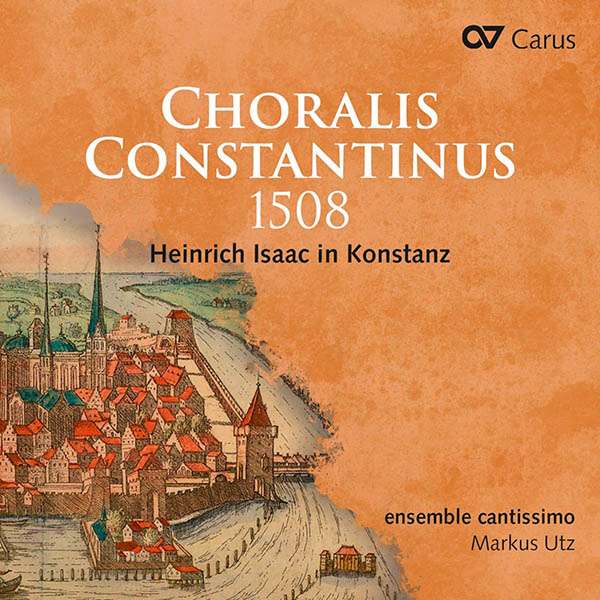Auch wenn der um die Mitte des 15. Jahrhunderts geborene Heinrich Isaac im Schatten der großen Renaissancekomponisten steht, gehört er doch ohne Zweifel in diese Reihe. Neueste Studien dokumentieren seinen Stellenwert, wozu auch das Projekt des in Konstanz beheimateten Ensemble Cantissimo unter der Leitung von Markus Utz gehört. Diese Künstler haben es sich zum Ziel gesetzt hat, das Schaffen Isaacs in Ton und Bild zu dokumentieren. Den Auftakt dazu bildet die bei Carus erschienene CD Choralis Constantinus 1508 – Heinrichs Isaac in Konstanz.
Mit 18 Tracks gibt die Aufnahme mit 13 Ersteinspielungen einen anregenden Einblick in jene Musik, die Isaac (in Verwaltungsdokumenten übrigens als erster offiziell als Komponist genannt) Anfang des 16. Jahrhunderts für den 1507 in Konstanz einberufenen Reichstag komponierte. Insgesamt drei Bände füllen diese Werke; das Projekt des Ensemble Cantissimo widmet sich Stücken aus dem ersten Buch.
Die Werkauswahl für die CD, auf der auch Musiker des Concerto Dell’Ombra zu hören sind, dokumentiert die stilistische Vielfalt der Musik Isaacs und beinhaltet neben dem kompletten Offizium für Weihnachten auch Vertonungen berühmter Texte wie ein Ave Maria, ein Magnificat und ein Veni sancte Spiritus. Die Künstler musizieren dabei in alternierenden Besetzungen aus Solisten, Chor a cappella und Zinken- bzw. Posaunen-Quartett, was das Klangbild noch einmal farbiger macht.
Die Aufnahmen fanden in der Kirche St. Peter & Paul auf der Insel Reichenau statt und fangen den Gesang in einer ansprechend tragenden Akustik ein. Jedes Chor-Register (SATB) ist mit drei exzellenten Stimmen besetzt. Das Ensemble singt dabei faszinierend homogen sowie transparent und mischt sich mit den behutsam musizierenden Instrumentalstimmen zum delikaten Tutti. Das Aufblühen des Klangs mit einer nie manierierten Dynamik und sein natürlicher Fluss eröffnen dem Hörer mit der glasklaren Intonation der Stimmen manch wunderbaren Kosmos.
Die intensive Konzentration auf die Musik ist genauso hörbar wie das Glücksgefühl der Ausführenden spürbar, sich mit diesen Klängen zu beschäftigen. Der in den USA wirkende Isaac-Experte James D. Feiszli hat auf Basis der alten Stimmbücher die Noten für diese Aufnahme ediert und sie wissenschaftlich betreut. Im Booklet versichert er: « Wenn Sie den Gregorianischen Choral, die auf dem Choral basierende Polyphonie und die liturgische schätzen, werden Sie diese Kompositionen lieben.“ Dem sei hinzugefügt: und diese Aufnahme auch.
Even though Heinrich Isaac, who was born around the middle of the 15th century, is overshadowed by the great Renaissance composers, he undoubtedly belongs in this line. Recent studies document his status, including the project of the Constance-based Ensemble Cantissimo under the direction of Markus Utz. These artists have set themselves the goal of documenting Isaac’s work in sound and image. The CD Choralis Constantinus 1508 – Heinrich’s Isaac in Constance, published by Carus, marks the beginning of this project.
With 18 tracks and 13 premiere recordings the new release provides a stimulating insight into that music which Isaac (incidentally the first to be officially named as composer in administrative documents) composed at the beginning of the 16th century for the Imperial Diet convened in Constance in 1507. These works fill a total of three volumes; the Ensemble Cantissimo project is devoted to pieces from the first book.
The selection of works for the CD, which also features musicians from Concerto Dell’Ombra, is documenting the stylistic diversity of Isaac’s music and includes the complete Divine Office for Christmas as well as settings of famous texts such as an Ave Maria, a Magnificat and a Veni sancte Spiritus. The artists perform in alternating instrumentations of soloists, choir a cappella and tine or trombone quartet, which makes the sound even more colorful.
The recording took place in the church of St. Peter & Paul on the island of Reichenau and captures the singing in an appealing acoustic. Each choral register (SATB) features three excellent voices. The ensemble sings with fascinating homogeneity and transparency and blends with the carefully playing instrumental voices to form a delicate tutti. The blossoming of the sound with never mannered dynamics and its natural flow opens up many a wonderful cosmos to the listener with the crystal-clear intonation of the voices.
The intense concentration on the music is just as audible as the performers’ sense of happiness at being engaged with these sounds. The Isaac expert James D. Feiszli, who works in the USA, edited the notes for this recording on the basis of the old part books and supervised it scientifically. In the booklet he asserts, « If you appreciate Gregorian chant, chant-based polyphony, and liturgical, you’ll love these compositions. » To which may be added: and so will this recording.


















